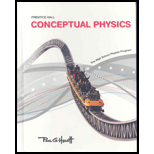
Concept explainers
If you live where there is snow, do as Benjamin Franklin did more than two centuries ago and lay samples of light and dark cloth on the snow. (If you don’t live in a snowy area, try this using ice cubes.) Describe differences in the rate of melting beneath the cloths.
Solids and liquids are better conductor than gases
Explanation of Solution
Introduction:
The process by which heat is directly transmitted through the fabric of a substance when there's a difference of temperature, without movement of the fabric, is understood as Conduction of heat.
When we put a steel pot above a stove, the within of the pot and therefore the food gets hot. Here heat is transferred through the metal bottom of the pot to the within. This is often an example of heat transfer by conduction.
Solids conduct heat better than liquids, which are successively better conductors than gases. The particles during a solid are most tightly bond and their positions are more or less fixed relative to every other as shown within the figure. The force between the adjacent particles is robust, making heat transfer by collision the foremost efficient.
The particles in liquid can move around within it, which suggests that the force between particles isn't as strong as solid. Thus liquids are usually poor conductors of warmth.
In the gas, the particles are far apart, making energy transfer by collision very inefficient. Thus gases, like air, are very poor conductors of warmth. Actually gases transfer heat by convection, during which heat moves in rising and falling air currents instead of by direct contact.
Conclusion:
So, for conduction of warmth to occur, a cloth medium is usually necessary. Conduction occurs mostly in solids. This will be understood if we see how solids, liquids and gases are sure to their respective atoms or molecules. Solids are tightly bound. The atoms or molecules cannot migrate from one side of the solid to the opposite, although the electrons can do so. Therefore conduction is more predominant in solids.
Chapter 22 Solutions
Conceptual Physics: The High School Physics Program
Additional Science Textbook Solutions
Essential University Physics (3rd Edition)
Applied Physics (11th Edition)
Conceptual Physics (12th Edition)
University Physics with Modern Physics (14th Edition)
University Physics Volume 2
Physics for Scientists and Engineers: A Strategic Approach, Vol. 1 (Chs 1-21) (4th Edition)
 College PhysicsPhysicsISBN:9781305952300Author:Raymond A. Serway, Chris VuillePublisher:Cengage Learning
College PhysicsPhysicsISBN:9781305952300Author:Raymond A. Serway, Chris VuillePublisher:Cengage Learning University Physics (14th Edition)PhysicsISBN:9780133969290Author:Hugh D. Young, Roger A. FreedmanPublisher:PEARSON
University Physics (14th Edition)PhysicsISBN:9780133969290Author:Hugh D. Young, Roger A. FreedmanPublisher:PEARSON Introduction To Quantum MechanicsPhysicsISBN:9781107189638Author:Griffiths, David J., Schroeter, Darrell F.Publisher:Cambridge University Press
Introduction To Quantum MechanicsPhysicsISBN:9781107189638Author:Griffiths, David J., Schroeter, Darrell F.Publisher:Cambridge University Press Physics for Scientists and EngineersPhysicsISBN:9781337553278Author:Raymond A. Serway, John W. JewettPublisher:Cengage Learning
Physics for Scientists and EngineersPhysicsISBN:9781337553278Author:Raymond A. Serway, John W. JewettPublisher:Cengage Learning Lecture- Tutorials for Introductory AstronomyPhysicsISBN:9780321820464Author:Edward E. Prather, Tim P. Slater, Jeff P. Adams, Gina BrissendenPublisher:Addison-Wesley
Lecture- Tutorials for Introductory AstronomyPhysicsISBN:9780321820464Author:Edward E. Prather, Tim P. Slater, Jeff P. Adams, Gina BrissendenPublisher:Addison-Wesley College Physics: A Strategic Approach (4th Editio...PhysicsISBN:9780134609034Author:Randall D. Knight (Professor Emeritus), Brian Jones, Stuart FieldPublisher:PEARSON
College Physics: A Strategic Approach (4th Editio...PhysicsISBN:9780134609034Author:Randall D. Knight (Professor Emeritus), Brian Jones, Stuart FieldPublisher:PEARSON





